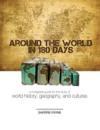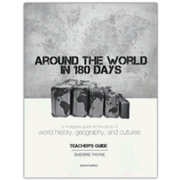Around the World in 180 Days is designed for teaching geography and world cultures to all of your children at the same time. It is written primarily for grades four through twelve, and suggestions are included for using the program with younger children down to kindergarten level. The “180 days” of the title refers to the approximate number of days in one school year, although you might take longer than that to complete the course if your children tackle more of the activities and suggested reading books.
The course is somewhat like a unit study. Continents serve as the organizing themes for each of the seven units. While history and geography are the primary subject areas covered, activities also draw students into religion, science, composition, speech, art, literature, and government. Religion actually plays a significant role, and it’s taught with an evangelistic/missionary outlook from a Protestant viewpoint.
Students follow the “4 R” approach for learning. They research to learn factual information. They reason: based on the information, they respond to “how” and “why” questions. They relate by making connections to answer questions such as, “What does this mean to me?” and “How does this help me relate to this particular culture?” Finally, they record to create written documentation of what they have learned. Students use a three-ring binder to maintain their work.
The course includes a teacher’s guide and a student workbook. Each student working at fifth grade level or above needs his or her own student workbook. Fourth graders might be able to use the student workbook, but younger students will not. Page xiii has a generic list of activities to be used with younger learners. Many of their activities will still overlap what you are doing with older students.
The course serves as a study guide rather than as a complete self-contained course. Students will need reference resources including at least one core history textbook. While author Sherrie Payne recommends BJU Press’ junior high level World Studies for Christian Schools as her favorite, she also recommends other texts from BJU Press, A Beka Book, and Christian Liberty Press as potential spines. None of these have adequate coverage for every continent. Antarctica and Australia, in particular, have minimal coverage in any of these texts, so Payne recommends that you search your local library for whatever resources you might find. Students also need real books (from the library or elsewhere) and outline maps which you can purchase or create yourself.
Aside from introductory information on how to use the course, teacher’s guides are similar in content to the student workbooks, but with answers included. There are no extra teaching instructions for individual units. This reflects the reality that students do much of their work independently with parental or teacher assistance as needed.
Units for each continent all follow a similar outline, although they vary in the time required to complete them. Obviously, a study of Asia will take more time than a study of Antarctica.
The first page of each unit is a list of “Resources” that includes both recommended books and topics. For most units, a few different textbooks are suggested for use as spine (core) books from which students will gather most of their information. “Books of Interest” are suggestions for real books (both fiction and non-fiction) relating to each continent. Rough grade-level designations for the real books will help you select books for independent reading for each student. “Missionaries to Read About” and “Other People You May Want to Read About” list key historical figures in missionary outreach and just a few other historical characters who are worth further reading. You grasp the weight of the missionary emphasis when you see under “Asia” ten names for missionaries and only eight names of other people.
Each unit is then broken down into sections on geography, history, religion, culture, and current events.
The geography section begins with a list of things to “identify” using an atlas, encyclopedia, textbooks, or other books. You might also use the internet, but you should be cautious about students getting all of their information from the internet; they will benefit from learning to locate information within books too. A dictionary is needed for the next section where they write definitions for geographical terms. Students next tackle a section of ten or more geography questions that will have them searching through their various resources (and the internet) looking for information such as “four animals that are native to Australia” (p.41) and “the name of the desert located in northern Chile” (p. 77). Students complete map activities by filling in an outline map with countries, cities, bodies of water, mountains, deserts, and other places. The geography section concludes with “Geography Activity Suggestions.” Students (or parents) will select from among the activities those most appropriate. Some activities are good for all ages while some are identified as being most appropriate for a particular age group. These activities are where you encounter most of the cross-curricular work. For example, one activity is to research one animal found in Latin America. Students prepare either a written or oral report. Then they might draw their own picture of the animal. This particular activity crosses over into science, composition, speech, and art. There are five or more activity suggestions for each unit except Antarctica which has only two.
The history section of each unit begins with a list of terms to identify. Next is an extensive list of “Study Questions” that will again require students to read and search through all of their resources. Most of these questions require short, simple answers while a few require lengthier responses or explanations. The next section has suggestions for further research on the history of that particular continent. These questions seem to be the ones that will require the most reading, research, and writing. One assignment says, “List some of the contributions of the Greek and Roman civilizations to Western culture. Include areas such as law, art, mathematics, literature, architecture, and drama” (p. 149). Another assignment directs students to research political and cultural differences between Eastern Europe and Western Europe and their causes (p. 151). These “further research” questions do not have suggested answers, so parents will have to do some work of their own to evaluate student responses.
The next part of the unit focuses on religion. It begins with terms to define. These are followed by study questions and then a section of “Suggestions for Further Research on the Religions of [each continent].” Questions in both these sections are similar to those in both the geography and history sections, requiring reading and research through the various resources. Religion questions direct students toward a Protestant worldview. For example, European church history deals almost exclusively with the Protestant Reformation.
The culture section of each unit varies. Most start with a list of terms to identify, although “Europe” begins with a fun quiz that might also serve as an assignment to identify terms students do not already know. Study questions follow in most units, then suggestions for further research. The culture studies are very narrow for most units. For example, for North America, cultural questions and activities are all about Native Americans, both Eskimos and Indians. Cultural studies are much too narrow and limited to provide a modern-day cultural understanding of any of the people groups.
The brief culminating section of each unit, “Current Events,” has students clip and paste current news articles in their notebook. They complete a chart identifying the source and topic of each article. It seems to me that having a student research or write about one or more of these articles would be an excellent way to make these articles more than just a collection.
Each section within each unit also has space for ideas and notes that student might jot down as they do their research. It seems to me that parents might also add their own activity suggestions from time to time based on resources you come across or particular interests of each child, and this might be a good place to write them.
Parents need to be selective about the number and types of activities they expect each student to accomplish. Younger students will generally answer fewer of the questions, complete fewer activities, and read fewer supplemental books than older students. While parents need to help introduce units and supervise work, students should be completing much of it on their own.
I think the study is great for upper elementary grades through junior high. However, high schools students should be working beyond the basic terms and simple questions that are provided for all students. They should have studied much of this in earlier years, and they should be spending their time on the more challenging work that shows up in the suggested activities. Parents with older students might adjust coursework for high schoolers, having them skip the basic information, instead having them spend more time on the complex questions and more challenging reading.
In summary, the approach used in Around the World in 180 Days is much more interesting than just using a textbook. When students are presented with questions and sent to find particular information, it focuses their attention much better than just assigning pages to be read from a textbook.










